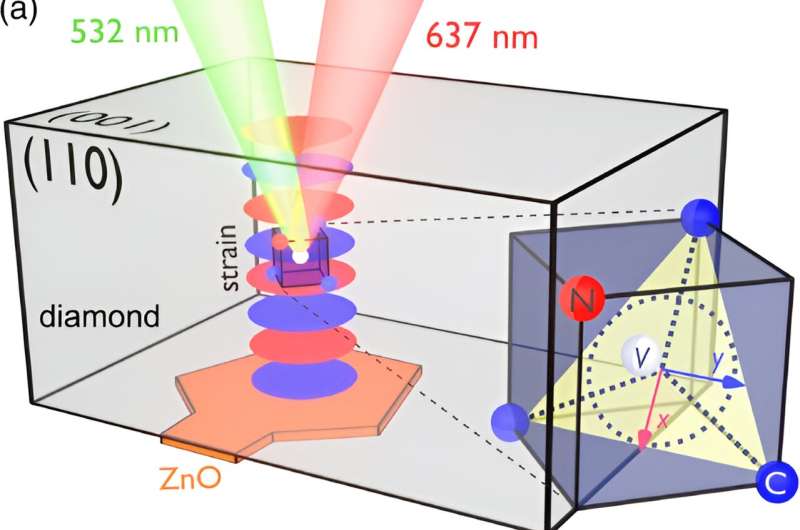This article has been reviewed according to Science X's editorial process and policies. Editors have highlighted the following attributes while ensuring the content's credibility:
fact-checked
peer-reviewed publication
trusted source
proofread
Sound drives 'quantum jumps' between electron orbits

Cornell University researchers have demonstrated that acoustic sound waves can be used to control the motion of an electron as it orbits a lattice defect in a diamond, a technique that can potentially improve the sensitivity of quantum sensors and be used in other quantum devices.
Advances in quantum information technology require finding new ways to control electrons and other microscopic particles. In an article titled "Coherent acoustic control of defect orbital states in the strong-driving limit," Gregory Fuchs, professor of applied and engineering physics, and his postdoctoral associate, Brendan McCullian, collaborated with Erich Mueller, professor of physics in the College of Arts and Sciences, and his doctoral student, Vaibhav Sharma, to engineer a setting where sound waves can drive "quantum jumps" between electron orbits.
The work was published in the journal PRX Quantum.
McCullian built a microscopic speaker on the surface of a diamond chip, which operated at a frequency that exactly matched an electronic transition. Using techniques similar to those employed in magnetic resonance imaging, he was able to demonstrate coherent control of a single electron inside the diamond chip.
Qubits—the quantum analog of the bits found in a classical computer—must remain coherent, or in a stable state, in order to do something useful. This coherence is very fragile and is easily lost by fluctuations of the environment, such as when a nearby electron jumps from one location to another. For many years, scientists have extended qubit coherence times by using a technique called spin resonance, which uses microwaves and magnetic fields to alter the electron behavior. Fuchs and his group attempted to extend this technique to the acoustic domain and improve the coherence of the orbitals.
"We acoustically drove the orbital states in a way that's somewhat analogous to the spin resonance, and then used the established toolbox of spin resonance techniques to investigate the coherence of that orbital state," said Fuchs. "It was very interesting to us that we could do an orbital version of spin resonance: take those tools that we know from spin resonance—for example, coherent control and Rabi oscillations—and with a couple-gigahertz acoustic resonator, map that onto the orbital states and see that those techniques are still valid."
Fuchs's work helps advance knowledge of the nitrogen-vacancy (NV) center, a defect in diamond crystal lattices that is an important qubit for sensing and quantum networking, and helps develop new tools to combat environmental fluctuations that lead to spectral diffusion, which can cause major problems in quantum networking applications that rely on a steady optical transition where the frequency of every emitted photon is the same.
"By investigating how the NV center interacts with these noise sources and finding ways to modify that interaction using tools that we normally reserve for spins, we've figured out a way that we can make it work with the orbital states. That is an important addition to science," said Fuchs. "This project was also an example of the way collaboration between teams should work. The experimental techniques were developed in my lab, but then we collaborated with a group in the Department of Physics that provided a theoretical analysis and helped us frame our predictions and understanding of the results."
"It was a hugely rewarding collaboration," said Mueller. "The acoustic waves excited the electrons through a mechanism similar to how one 'pumps' on a playground swing. When the vibrations are in sync with the electron motion they can transfer energy to it. It is truly amazing that one can control the electron motion with what is essentially a loudspeaker."
More information: B.A. McCullian et al, Coherent Acoustic Control of Defect Orbital States in the Strong-Driving Limit, PRX Quantum (2024). DOI: 10.1103/PRXQuantum.5.030336
Journal information: PRX Quantum
Provided by Cornell University





















